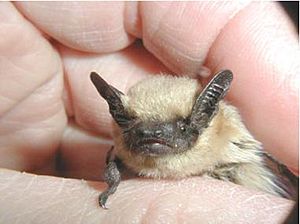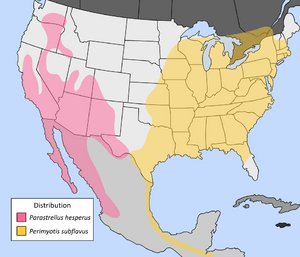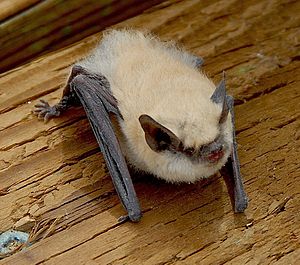Canyon bat facts for kids
Quick facts for kids Canyon bat |
|
|---|---|
 |
|
| Conservation status | |
| Scientific classification | |
| Genus: |
Parastrellus
|
| Species: |
hesperus
|
The canyon bat (Parastrellus hesperus) is a tiny bat also called the western pipistrelle. It's a type of vesper bat. You can find it in Mexico and the western United States. For a long time, scientists thought it belonged to the Pipistrellus group. But in 2006, new studies showed it was different. So, they gave it its own special group called Parastrellus.
Contents
About the Canyon Bat
The canyon bat is the smallest bat in the United States. Its wings can spread about 190–215 mm (7.5–8.5 inches) wide. Its body is usually 62–80 mm (2.4–3.1 inches) long. Female bats are often a little bigger than males.
What They Look Like
Canyon bats can be white, pale yellow, or dark brown. They have a special coloring called countershading. This means they are dark on top and lighter underneath. Their faces, ears, feet, and wings are usually very dark, almost black.
Their fur is short, soft, and thick. The hairs are black at the bottom and get lighter towards the tips. Their wings are mostly hairless. Only the lower part of the membrane between their legs has some hair. Their toes also have a few fine hairs.
How They Fly
Canyon bats have short, wide wings. This wing shape helps them fly very slowly, sometimes as slow as 5 miles per hour. It also makes them very good at turning quickly. They have a short, wide head and small ears. Inside their ears, they have a tiny, club-shaped part called a tragus.
Where Canyon Bats Live
You can find P. hesperus in the deserts and low areas of the western United States and Mexico. They are most common in the deserts of the southwestern U.S. Their range goes north to Washington state and south into Mexico. A small group has also been found in north-central Texas and Oklahoma.
These bats prefer lower elevations, usually below 5,000 feet. They are often the most common bats in these areas.
Their Homes During the Day
During the day, canyon bats like to rest in cracks in rocks. Some have also been found resting in cracks inside old mines. They might also roost in buildings, under rocks, or in thick plants. However, rocky cracks are their favorite spots.
Because they are so small, canyon bats can easily get dehydrated in the desert heat. They need to find a safe, cool place to spend the day. This helps them avoid drying out. Scientists think they might sometimes use burrows made by kangaroo rats, but there is no strong proof yet. In some places, they might even roost in rock piles along highways or railroads.
Canyon Bat Habits and Family Life
Canyon bats are often the first bats to appear in the evening. They are also the last ones seen after sunrise. They are most active right after sunset and before sunrise. They usually don't fly much during the middle of the night. Sometimes, they have even been seen flying in full sunlight during the late morning.
What They Eat
Canyon bats are insectivores, meaning they eat insects. Their flight looks a bit wobbly and fluttery. Their special wings help them move quickly and change direction. This is very useful when they are hunting flying insects.
Hibernation and Winter Habits
When the weather gets cold or there isn't enough food, canyon bats will hibernate. This means they go into a deep sleep. However, both male and female bats sometimes wake up and fly around during winter. They don't do this as much as in warmer months. Canyon bats hibernate alone in mines, caves, and rock cracks. They are not known to hibernate in large groups.
Raising Their Young
Female canyon bats usually give birth in June. They typically have two babies at a time, but sometimes only one. These bats are mostly solitary, so females often raise their young alone. Sometimes, they form small groups called maternity colonies, but these usually have no more than a dozen bats. Young bats can usually fly within 2 to 3 weeks after they are born.
See also
 In Spanish: Parastrellus hesperus para niños
In Spanish: Parastrellus hesperus para niños




